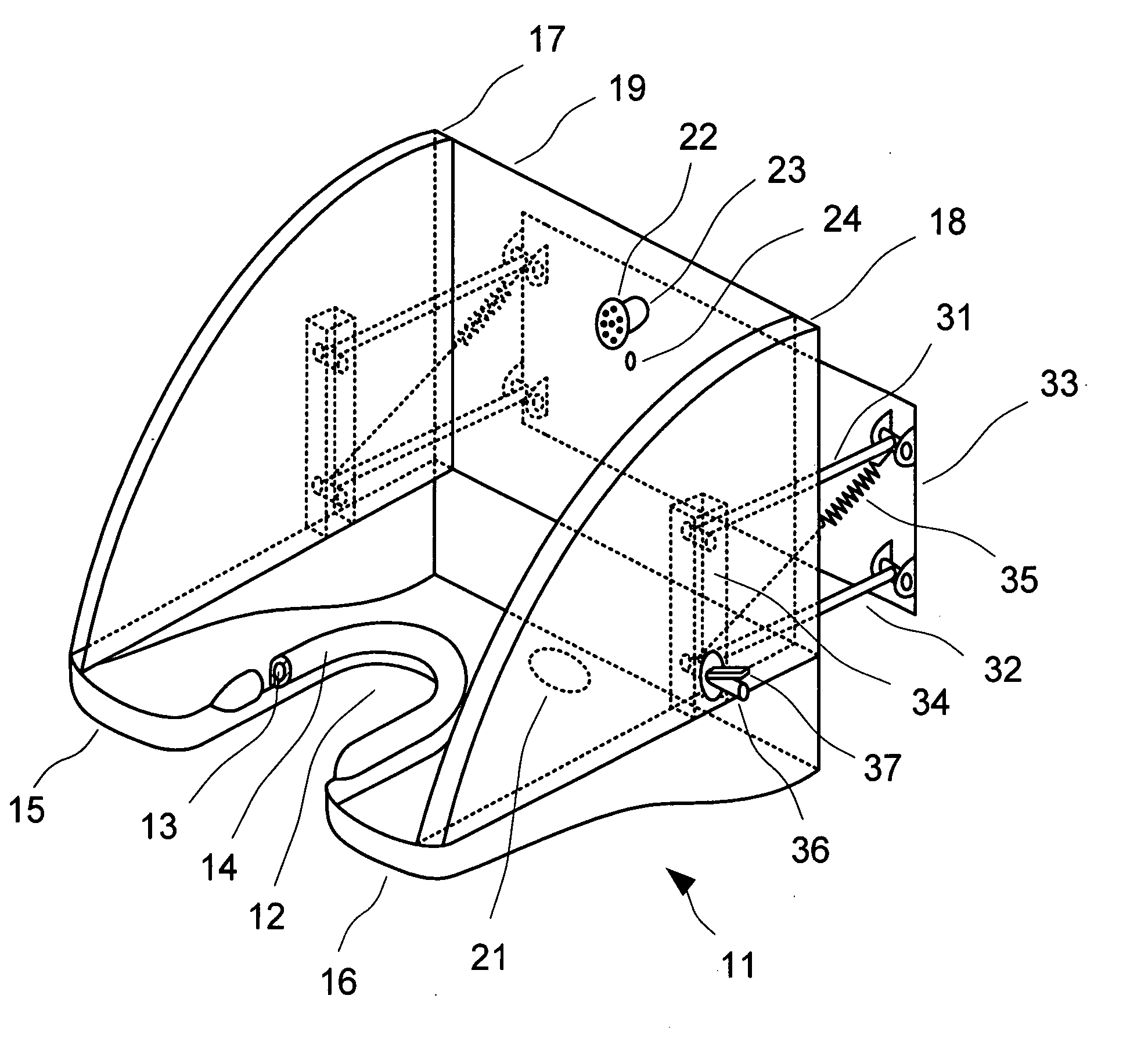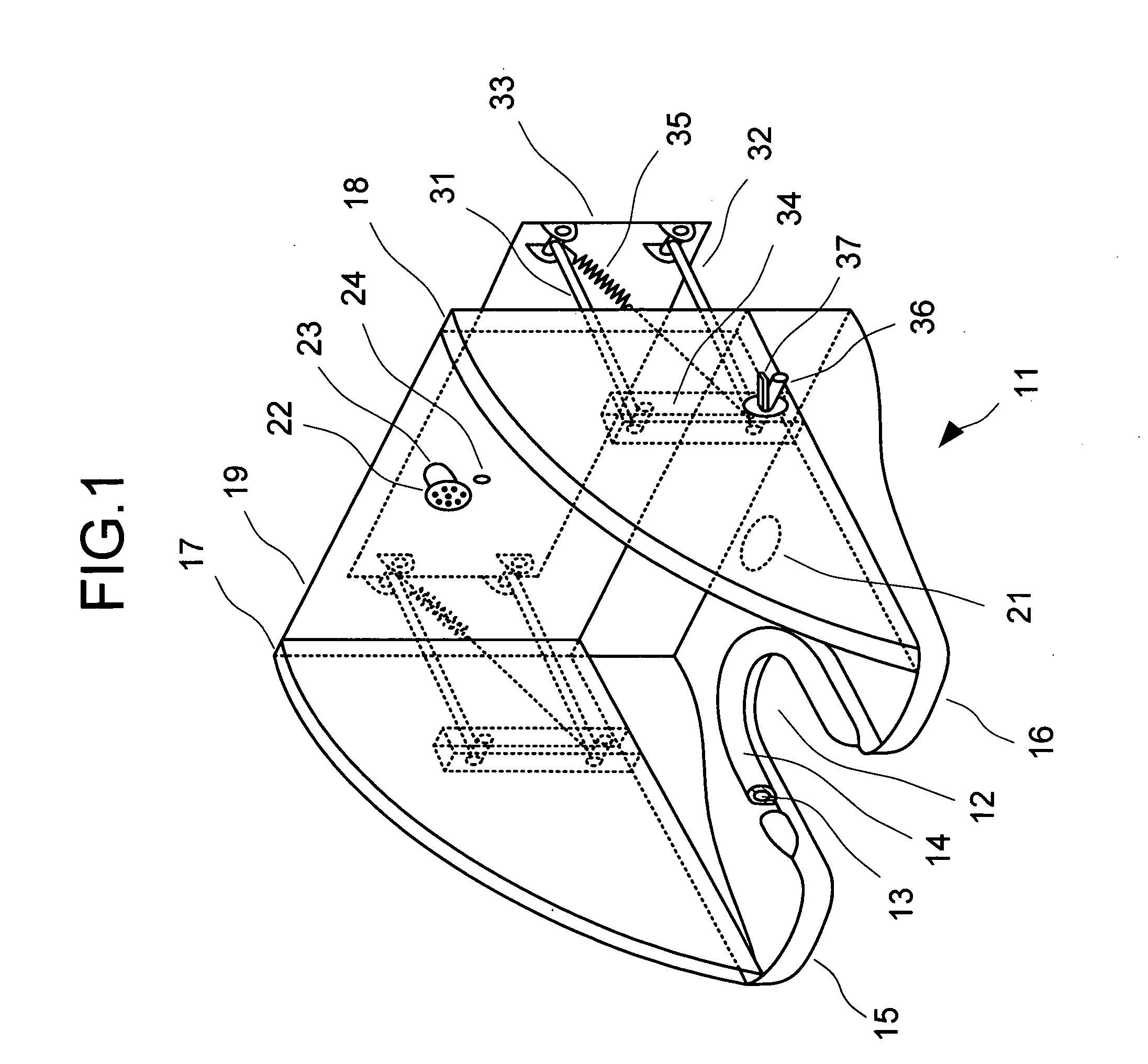However, the U.S. Pat. No. 3,768,483 teaches only use of steam as face
cleaning agent, and does not allow use of hot or cold water, which might be preferred by users depending on a number of conditions (ambient temperature, for example).
No provisions are made for easy replacement or cleaning of the device's parts that come into contact with user's face,
nose, or mouth; therefore, the device is not readily adaptable for using in public facilities.
Further, the U.S. Pat. No. 3,768,483 does not address position adjustment of the hood or application of the invention for scalp or
hair treatment.
However, the invention described in U.S. Pat. No. 4,223,668 does not provide for scalp or
hair treatment, nor does it address using of cleansing or
skin care agents.
Since the apparatus described is essentially a full-face
mask, it does not allow the user to use his or her hands to aid face washing.
The described water dispensing means do not allow regulation of
water pressure or massaging intensity.
Furthermore, no provisions are made for easy replacement or cleaning of the device's parts that come into contact with user's face or
nose; therefore, the device is not readily adaptable for using in public facilities.
However, Fukunaga et al. do not teach position adjustment of the
bathing apparatus or any other means that would allow users to change their posture and / or position relative to the device.
The U.S. Pat. No. 5,181,510 does not teach height adjustment of the facial vaporizing device to provide a more comfortable user position.
Moreover, Peters does not teach any face or scalp massaging action in conjunction with her invention, nor does she mention using hands for additional face care or other hygienic purposes.
Furthermore, Brugger does not describe adjustment of the basin position to allow more comfortable user's position than a conventional leaning backwards towards the basin.
The U.S. Pat. No. 4,933,998 teaches only treatment of hair wherein the tray is located mostly behind user's neck and does not teach face washing or care.
While providing the adjustable sink suitable for example for children, adults, and people confined to wheelchairs, U.S. Pat. No. 4,233,693 does not teach sinks specifically aimed at face,washing.
The adjustment means described in that patent link the upward and outward motion of the
shampoo bowl and do not provide for independent vertical and horizontal adjustments thereof.
The
shampoo bowl as described in U.S. Pat. No. 4,821,347 requires a second person to wash the
client's hair and does not address hands-free washing process.
The U.S. Pat. No. 6,076,202 does not teach hands-free face washing or special faucets specifically intended for face washing and care.
The U.S. Pat. No. 6,665,892 teaches the arcuate motion of the washbasin that inherently links upward and downward motion to the
translational motion closer to or away from the
client and does not provide for independent vertical and horizontal adjustments of the washbasin.
From the drawings it can be seen that while providing for the vertical adjustment of the sink that patent does not address a washing apparatus specifically aimed at washing person's hair or scalp, nor does it provide for a comfortable
accommodation of person's head or neck.
The U.S. Pat. No. 3,731,325 to Guarassi does not teach height adjustment of the described sink attachment to maintain a comfortable posture, nor does it teach a hands-free operation.
Moreover, this invention does not provide for utilization of user's hands to enhance cleansing and / or massaging when desired.
Also, the U.S. Pat. No. 3,934,596 does not teach a height adjustment to accommodate users of different heights, nor does it allow the user to comfortably stand or sit upright while using the shampooing apparatus.
The U.S. Pat. No. 5,239,711 does not teach height adjustment of the described headrest to maintain a comfortable posture, nor does it teach a hands-free operation.
First, Magee's invention is specifically designed for
hair washing, and does not provide for a convenient face wash and care.
Due to its rather complex design with two bowls, guard cape, and other features, Magee's device requires a substantial time to set up and cannot be used unassisted.
Moreover, since a part of the device's weight is supported on
client's shoulders, its use can be uncomfortable, especially for people with disabilities, elderly, and
small children.
Further, Magee's device does not provide for a hands-free operation, and requires at least one hand of the
service provider to operate the flexible liquid-delivery hose with a
nozzle to aim the
water flow to the area to be washed, making the
hair washing process quite cumbersome and complicated.
The U.S. Pat. No. 6,415,458 does not teach the hands-free operation and requires an
external source of working fluid.
While functional for its intended purpose, the invention of Mazzulla et al. is specifically designed for
hair washing, and does not provide for a convenient face wash and care.
The device described by the U.S. Pat. No. 6,694,540 does not provide for a hands-free operation and cannot be used unassisted.
While the head washing cap of U.S. Pat. No. 5,940,885 is applicable to users of different head sizes, it is expressly designed to prevent water from coming in contact with a face of a user and does not discuss hands-free operation or position adjustment to allow for a more comfortable user posture.
However, Shimizu teaches about application of the waterproof sheet only to hair washing, and does not discuss face wash or care.
Moreover, Shimizu's invention is specifically designed to be used with a conventional automatic hair washing apparatus and does not address adjustment of the position of the hair
washer to allow for a more comfortable user posture.
However, Speelman's invention does not teach face treatment or care, nor does it provide for a hands-free operation.
Moreover, U.S. Pat. No. 6,519,777 does not address means of supplying the working fluid to user's hair and therefore depends on conventional means such as water faucets and hoses.
 Login to View More
Login to View More  Login to View More
Login to View More 


